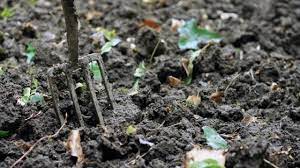Natural Factors Influencing the Amount of Organic Matter
The transformation and movement of materials within soil organic matter pools is a dynamic process influenced by climate, soil type, vegetation and soil organisms. All these factors operate within a hierarchical spatial scale.
Soil organisms are responsible for the decay and cycling of both macronutrients and micronutrients, and their activity affects the structure, tilth and productivity of the soil. In natural forest ecosystems without human disturbance, the living and non-living components are in dynamic equilibrium with each other.
The litter on the soil surface beneath different canopy layers and high biomass production generally result in high biological activity in the soil and on the soil surface.
The following five mechanisms of natural factors influencing the amount of organic have been distinguished:
A continuous soil cover of living plants, which together with the soil architecture facilitates the capture and infiltration of rainwater and protects the soil;
A litter layer of decomposing leaves or residues providing a continuous energy source for macro- and micro-organisms;
The roots of different plants distributed throughout the soil at different depths permit an effective uptake of nutrients and an active interaction with microorganisms;
The major period of nutrient release by micro-organisms coincides with the major period of nutrient demand by plants;
Nutrients recycled by deep-rooting plants and soil macrofauna and microfauna.
Natural Factors Influencing the Amount of Organic Matter
The environmental and edaphic factors that control the activity of soil biota, and thus the balance between accumulation and decomposition of organic matter in the soil, are described below.
1. Temperature
Several field studies have shown that temperature is a key factor controlling the rate of decomposition of plant residues. Decomposition normally occurs more rapidly in the tropics than in temperate areas.
Reaction rates doubled for each increase of 8-9 °C in the mean annual air temperature. The relatively faster rate of decomposition induced by the continuous warmth in the tropics implies that high equilibrium levels of organic matter are difficult to achieve in tropical agro-ecosystems.
Hence, large annual rates of organic inputs are needed to maintain an adequate labile soil organic matter pool in cultivated soils. Soils in cooler climates commonly have more organic matter because of slower mineralization (decomposition) rates.
2. Soil Moisture and Water Saturation
Soil organic matter levels commonly increase as mean annual precipitation increases. Conditions of elevated levels of soil moisture result in greater biomass production, which provides more residues, and thus more potential food for soil biota.
On the other hand, periods of water saturation lead to poor aeration. Most soil organisms need oxygen, and thus a reduction of oxygen in the soil leads to a reduction of the mineralization rate as these organisms become inactive or even die. Some of the transformation processes become anaerobic, which can lead to damage to plant roots caused by waste products or favorable conditions for disease-causing organisms.
Read Also : Properties of Soil Organic Matter and Crop Production
3. Soil Texture
Soil organic matter tends to increase as the clay content increases. This increase depends on two mechanisms.
First, bonds between the surface of clay particles and organic matter retard the decomposition process.

Second, soils with higher clay content increase the potential for aggregate formation. Macro-aggregates physically protect organic matter molecules from further mineralisation caused by microbial attack.
For example, when earthworm casts and the large soil particles they contain are split by the joint action of several factors (climate, plant growth and other organisms), nutrients are released and made available to other components of soil micro-organisms.
Under similar climate conditions, the organic matter content in fine textured (clayey) soils is two to four times that of coarse textured (sandy) soils.
4. Topography
Organic matter accumulation is often favoured at the bottom of hills. There are two reasons for this accumulation: conditions are wetter than at mid- or upper-slope positions, and organic matter is transported to the lowest point in the landscape through runoff and erosion.
Similarly, soil organic matter levels are higher on north facing slopes (in the Northern Hemisphere) compared with south-facing slopes (and the other way around in the Southern Hemisphere) because temperatures are lower.
5. Salinity and Acidity
Salinity, toxicity and extremes in soil pH (acid or alkaline) result in poor biomass production and, thus in reduced additions of organic matter to the soil.
For example, pH affects humus formation in two ways: decomposition, and biomass production. In strongly acid or highly alkaline soils, the growing conditions for micro-organisms are poor, resulting in low levels of biological oxidation of organic matter.
Soil acidity also influences the availability of plant nutrients and thus regulates indirectly biomass production and the available food for soil biota. Fungi are less sensitive than bacteria to acid soil conditions.
6. Vegetation and Biomass Production
The rate of soil organic matter accumulation depends largely on the quantity and quality of organic matter input.
Under tropical conditions, applications of readily degradable materials with low C:N ratios, such as green manure and leguminous cover crops, favour decomposition and a short-term increase in the labile nitrogen pool during the growing season.
On the other hand, applications of plant materials with both large C:N ratios and lignin contents such as cereal straw and grasses generally favour nutrient immobilization, organic matter accumulation and humus formation, with increased potential for improved soil structure development.
Root turnover also constitutes an important addition of humus into the soil, and consequently it is important for carbon sequestration. In forests, most organic matter is added as superficial litter. However, in grassland ecosystems, up to two-thirds of organic matter is added through the decay of roots.
In summary, the availability, transformation and amount of soil organic matter is a dynamic process influenced by certain factors which may be climate, soil type, vegetation and soil organisms.
Read Also : Irrigation Companies Near Me: A Guide To Finding The Best Services









